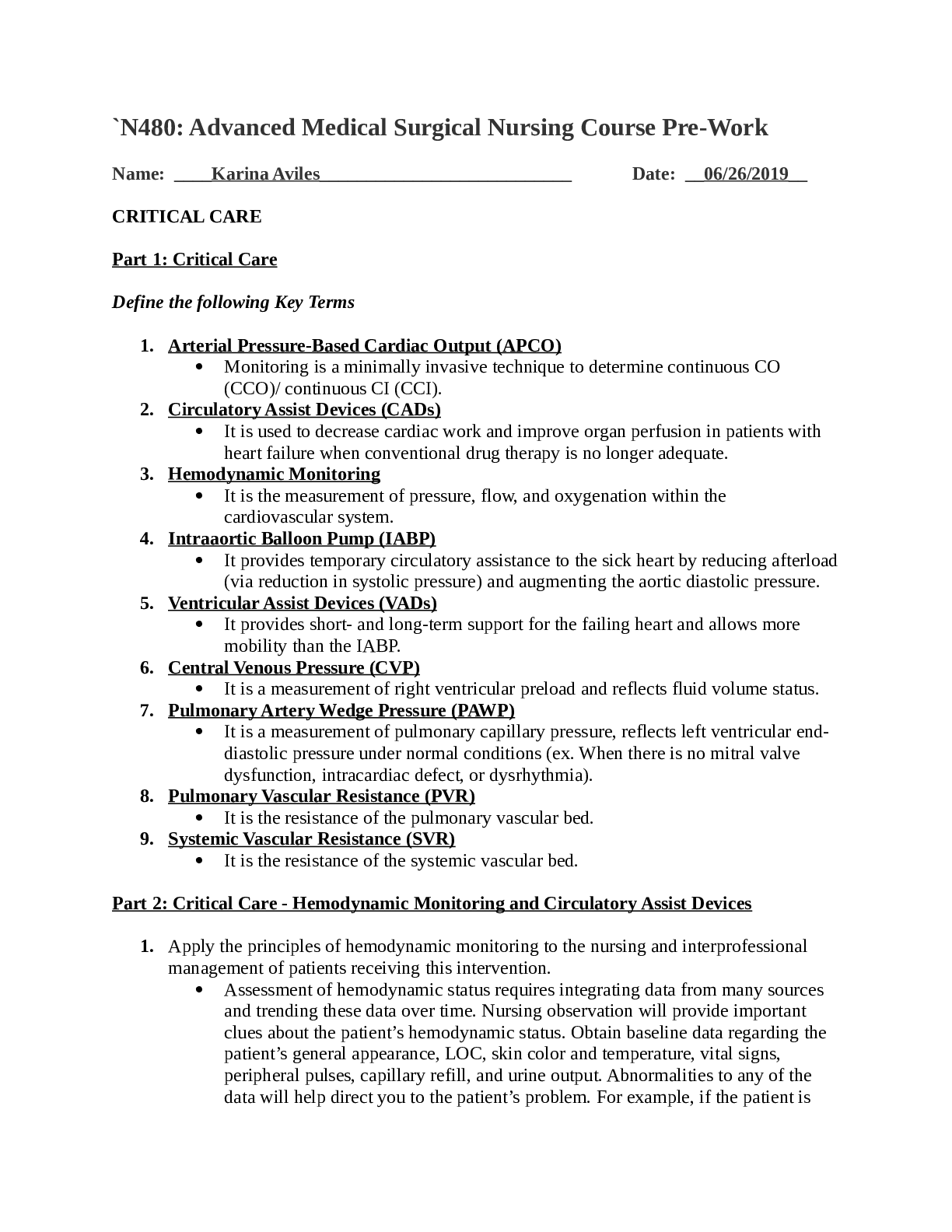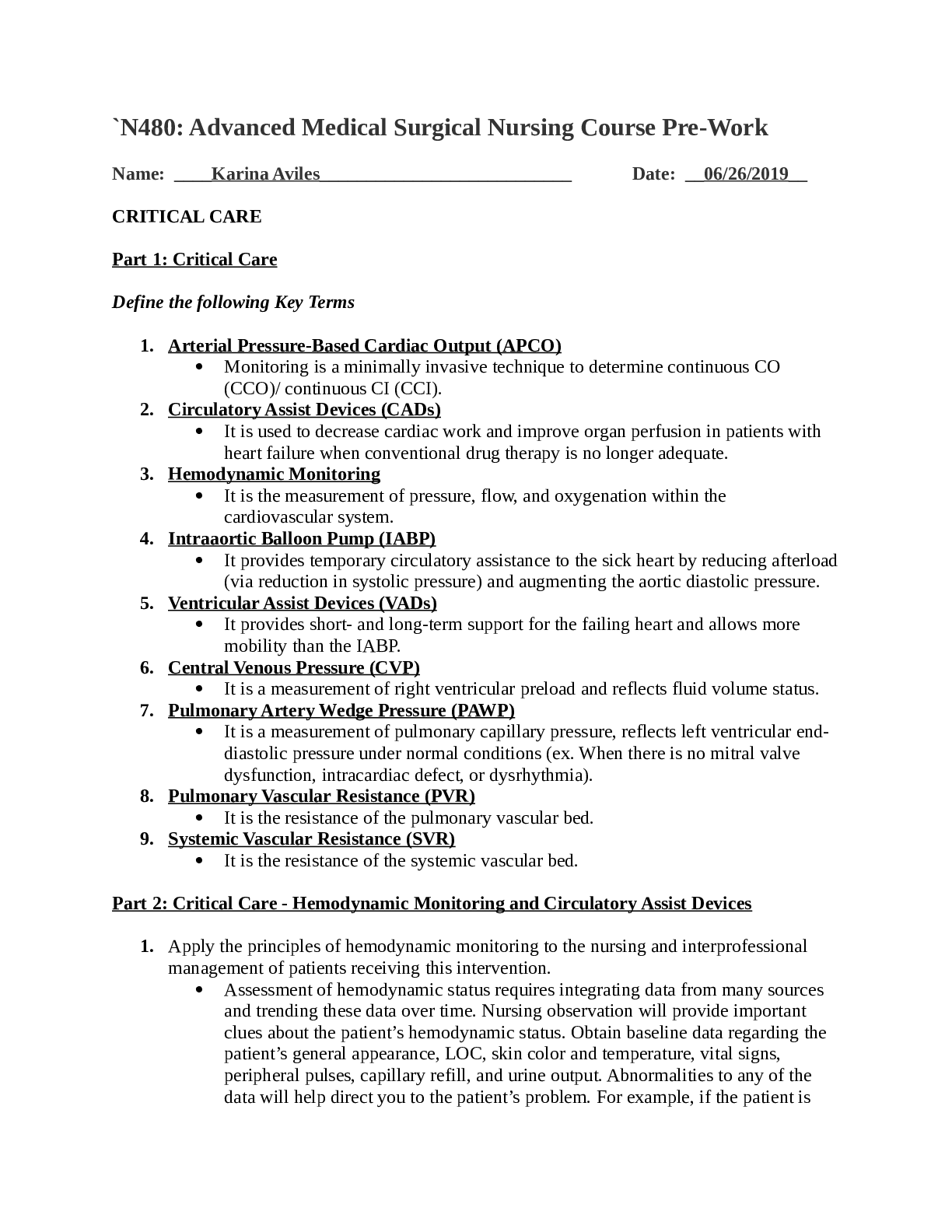Part 1: Critical Care
Define the following Key Terms
1.2.3.4.5.6.7.8.9.Arterial Pressure-Based Cardiac Output (APCO)
Monitoring is a minimally invasive technique to determine continuous CO
(CCO)/ continuous CI (CCI).
Circulatory Assist Devices (CADs)
It is used to decrease cardiac work and improve organ perfusion in patients with
heart failure when conventional drug therapy is no longer adequate.
Hemodynamic Monitoring
It is the measurement of pressure, flow, and oxygenation within the
cardiovascular system.
Intraaortic Balloon Pump (IABP)
It provides temporary circulatory assistance to the sick heart by reducing afterload
(via reduction in systolic pressure) and augmenting the aortic diastolic pressure.
Ventricular Assist Devices (VADs)
It provides short- and long-term support for the failing heart and allows more
mobility than the IABP.
Central Venous Pressure (CVP)
It is a measurement of right ventricular preload and reflects fluid volume status.
Pulmonary Artery Wedge Pressure (PAWP)
It is a measurement of pulmonary capillary pressure, reflects left ventricular end-
diastolic pressure under normal conditions (ex. When there is no mitral valve
dysfunction, intracardiac defect, or dysrhythmia).
Pulmonary Vascular Resistance (PVR)
It is the resistance of the pulmonary vascular bed.
Systemic Vascular Resistance (SVR)
It is the resistance of the systemic vascular bed.
Part 2: Critical Care - Hemodynamic Monitoring and Circulatory Assist Devices
1.Apply the principles of hemodynamic monitoring to the nursing and interprofessional
management of patients receiving this intervention.
Assessment of hemodynamic status requires integrating data from many sources
and trending these data over time. Nursing observation will provide important
clues about the patient’s hemodynamic status. Obtain baseline data regarding the
patient’s general appearance, LOC, skin color and temperature, vital signs,
peripheral pulses, capillary refill, and urine output. Abnormalities to any of the
data will help direct you to the patient’s problem. For example, if the patient is
2.Differentiaterelatedskin is cool, pallor, and diminished pulses may indicate decreased CO. If the
patient’s urine output is irregular in the volume or content, there might be a
problem with the patient’s kidney. There are invasive and noninvasive
hemodynamic monitoring, depending on the patient’s condition you will be
prompted to use one or the other.
the purpose of, indications for, and function of circulatory assist devices and
nursing and interprofessional management.
Circulatory assist devices (CADs) are used to decrease cardiac work and improve
organ perfusion in patients with heart failure when conventional drug therapy is
no longer adequate. CADs provide interim support in three types of situations (1)
the left, right, or both ventricles require support while recovering from acute
injury (2) the patient must be stabilized before surgical repair of the heart (ex.
Ruptured septum) and (3) the heart has failed, and the patient is awaiting heart
transplantation. It decreases cardiac workload, increase myocardial perfusion, and
augment circulation.
Indications for the devices are patients that have refractory unstable angina (when
drugs have failed), short-term bridge to a heart transplantation, acute myocardial
infarction, preoperative, intraoperative, and postoperative cardiac surgery, or
high-risk interventional cardiology procedures.
Patient’s that requires any of the CADs requires highly skilled care. They must
perform frequent and thorough cardiovascular assessments, measurement of
hemodynamic parameters, auscultation of the heart and lungs, and evaluation of
the ECG. Assess for adequate tissue perfusion at regular intervals. They must
observe for any type of bleeding, cardiac tamponade, ventricular failure, infection,
dysrhythmias, renal failure, hemolysis, and thromboembolism. With the IABP,
patients must remain in bed with limited position changes that may need skin
breakdown assessment, like pressure ulcers. VAD patients may be mobile and
require an activity plan and in some cases are sent home. Patients with CADs will
recover, undergo heart transplantation, or receive an artificial heart. Many patients
do die or the decision to terminate the device is made and death is followed
afterwards. The patient and caregivers require emotional support and should
consult other team members like a social worker or clergy, as appropriate.
Part 3: Critical Care - Hemodynamic Monitoring and Circulatory Assist Devices
1.Which hemodynamic parameter best reflects the effectiveness of drugs that the nurse
gives to reduce a patient’s left ventricular afterload?
A. Mean arterial pressure (MAP)
B. Systemic vascular resistance (SVR)
C. Pulmonary vascular resistance (PVR)
D. Pulmonary artery wedge pressure (PAWP)
2.While waiting for heart transplantation, a patient with severe cardiomyopathy has a
ventricular assist device (VAD) implanted. When planning care for this patient, the nurse
should anticipate
A. preparing the patient for a permanent VAD.
Read More


